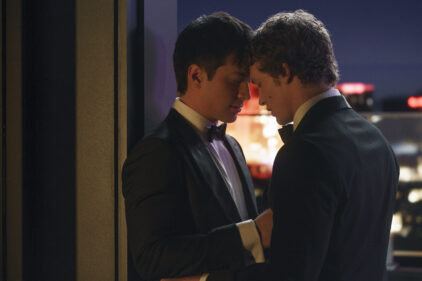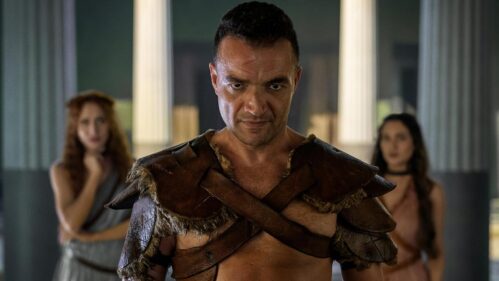“The river leads back there. It leads onward too, deeper,
into the wild.”
This line, like so many in Terrence Malick’s “The New World”
is delivered in narration, and can be read on multiple levels. On one, it is
about John Smith and the other settlers’ journey into a new land. On another,
it can be read philosophically, a commentary on the constant flow of life.
Watching the film 11 years after its release, I realized another meaning: the
river as a filmmaker’s career. For Malick, “The New World” feels like a bend in
the waterway, a film that both echoes themes he explored from his first time
behind the camera and charts the way to what he would produce after.
We all know that our interpretation of film often changes as
we age, and a filmmaker’s later work can allow us to see themes that began to
emerge at a time when we didn’t even notice it. The name Terrence Malick above
the title on “The New World” in 2006 certainly brought with it a certain group
of expectations for those of us who loved “Badlands,” “Days of Heaven” and “The
Thin Red Line,” but a decade later, released by Criterion this week in a
gorgeous three-disc Blu-ray set, the film now feels almost like a bridge between
those early works and his recent trio of introspective, deeply philosophical
films: “Tree of Life,” “To the Wonder” and “Knight of Cups.” I recently
suggested to someone that Malick’s ‘10s films were all variations on the search
for meaning: in childhood/family in “The Tree of Life,” in religion in “To the Wonder” and in
excess/sex/fame in “Knight of Cups.” Perhaps “The New World” should be included
in this search as well in that it is Malick looking back further than ever
before to the formative years of an entire nation. And while many reviews at
the time praised Malick’s incredible attention to detail (particularly in Jack
Fisk’s stunning production design), it is the philosophical underpinnings of
the film, at least in its 172-minute director’s cut, that resonated for me this
week. It’s a beautiful film that feels like both history and dream; both truth
and legend; both prose and poetry.

It’s not accidental that Malick chose the oft-told story of
Pocahontas through which to tell his story of “The New World.” As Roger wrote
at the time, after viewing both the 150-minute first cut and the 135-minute
theatrical cut: “Terrence Malick’s ‘The New World’ strips away
all the fancy and lore from the story of Pocahontas and her tribe and the
English settlers at Jamestown, and imagines how new and strange these people
must have seemed to one another.” There are scenes in “The New World” that feel
like realism—antidotes to the Hollywood vision of the Native American
experience in films like “Dances with Wolves.” Witness John Smith (Colin
Farrell) and Pocahontas (Q’orianka Kilcher) not as singing, dancing,
star-crossed lovers from a Disney cartoon but as two people equally confused by
and fascinated by each other. There’s a mesmerizing scene around 40 minutes
into the director’s cut in which the two teach other words and Smith draws
closer to her tribe, conveyed through Farrell and Kilcher’s remarkably natural
performances and Emmanuel Lubezki’s fluid camerawork.
And yet one looking for pure history lesson would only be
disappointed by “The New World.” As the story unfolds, and evolves from that of
John Smith to John Rolfe (Christian Bale), it never loses its dreamlike aesthetic, conveyed through Lubezki’s always-moving camera, but also through
characters who say more in narration than they do in dialogue. Smith’s
relationship with Pocahontas is related almost entirely via imagery and narration
“Love, shall we deny it when it visits us? Shall we not take what we are given?
There is only this. All else is unreal.” He says this not to her or in some
flashback construct in which he writes a journal, but to us, the viewer. “The New
World” is a direct channel not to the past but to the emotion of the day. The
confusion of two cultures clashing, the fascination they must have had with
each other, the eventual fear and betrayal—captured not in traditional storytelling
but the visual power of a masterful filmmaker. It is film not as a simple way to convey a story but a river, something natural, powerful and always changing.
The Criterion release of “The New World” is phenomenal,
including all three versions of the film (I too saw both versions in 2006 and
only watched the director’s cut this time) on separate discs, allowing for
absolutely pristine transfers of each of them. Special features are also
separated among the three discs and extensive. See the list below. And get your copy today before the river takes another turn.
·
New 4K digital restoration of the 172-minute
extended cut of the film, supervised by cinematographer Emmanuel Lubezki and
director Terrence Malick and featuring material not released in theaters, with
5.1 surround DTS-HD Master Audio soundtrack on the Blu-rays
·
High-definition digital transfers of the
135-minute theatrical cut and the 150-minute first cut of the film, supervised
by Lubezki, with 5.1 surround DTS-HD Master Audio soundtracks on the Blu-rays
·
New interviews with actors Colin Farrell and
Q’orianka Kilcher
·
New program about the making of the film,
featuring interviews with producer Sarah Green, production designer Jack Fisk,
and costume designer Jacqueline West
·
Making “The New World,” a documentary shot
during the production of the film in 2004, directed and edited by Austin Jack
Lynch
·
New program about the process of cutting “The New
World” and its various versions, featuring interviews with editors Hank Corwin,
Saar Klein, and Mark Yoshikawa
·
Trailers
PLUS: A book featuring an essay by film scholar Tom Gunning,
a 2006 interview with Lubezki from American Cinematographer, and a selection of
materials that inspired the production












